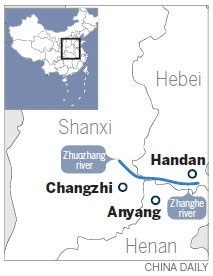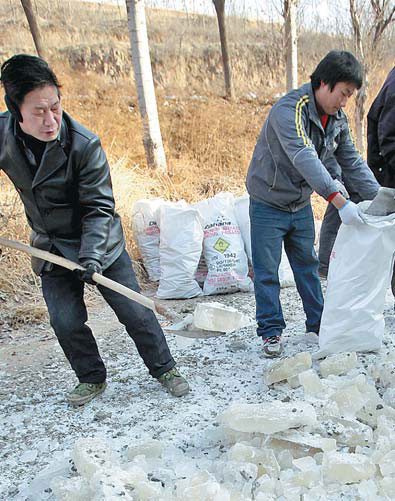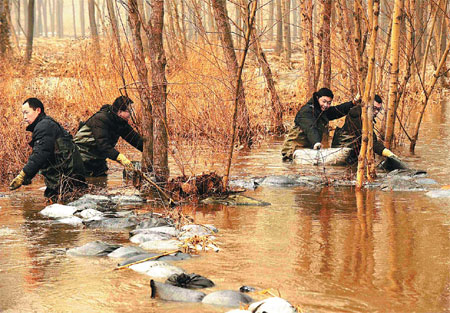Chemical leak into river puts focus on plant
Updated: 2013-01-11 08:08
By Wu Wencong and Sun Ruisheng in Shanxi and Peng Yining in Beijing (China Daily)
|
||||||||
|
Villagers in Changzhi, Shanxi province, remove contaminated ice from the Zhuozhang River on Wednesday. Zhang Wei / China Daily |
|
Workers place bags of activated carbon into the water to absorb contaminants in Yuecheng reservoir in Handan, Hebei province, after it was polluted by aniline that flowed in from Shanxi province. Zhu Xudong / Xinhua |

Delay in reporting incident raises concerns, report Wu Wencong and Sun Ruisheng in Shanxi and Peng Yining in Beijing.
The lower area of the field, containing hundreds of withered cornstalks, was covered by a sheet of reddish-brown ice. Hundreds of people armed with iron picks and shovels were cutting holes roughly half a meter in diameter in the ice, clearing away the nearly 5-centimeter-thick layer. They then tipped large bags of activated carbon - charcoal treated with oxygen - into the half-meter-deep water underneath to absorb the contaminants.
That was the scene on Wednesday at a reservoir in Changzhi in Shanxi province. Following a leak of aniline, a derivative of benzene used in several industrial processes, including dyeing and the production of pigments, the reservoir was flooded by the toxic chemical which is believed to cause liver and kidney damage.
The leak, caused by a crack in a delivery pipeline to a storage tank, of 30 tons of aniline, which has a density similar to water, was erroneously directed into the reservoir, which has lain unused since 1993.
As temperatures dropped to -13 C, the upper layer of aniline froze, allowing the clean-up teams to break the "ice" into pieces and ship it away, while using activated carbon to absorb the chemicals remaining in the unfrozen water below.
Almost 5,000 local people, including soldiers, police, and workers have been involved in the cleanup, according to the local emergency management office. By Wednesday afternoon, 670 metric tons of contaminated ice, and more than 750 tons of wastewater had been cleared away.
Ongoing investigation
It was the ninth day after chemical spill, reported on Dec 31, and an investigation team composed of officials and experts from the Ministry of Environmental Protection had just arrived in Changzhi. They had traveled from Handan in Hebei province, which has a population of more than 1 million people, and is one of the downstream cities affected by the aniline that flowed across the border from Shanxi.
"The investigation into the accident is ongoing. It's still far too early to discuss the issue of compensation," said Sui Xiaochan, a section head at the ministry's Center of Environmental Emergency and Accident Investigation and a member of the investigation team.
Four officials from the company that owns the plant, Tianji Coal Chemical Industry Group - a State-owned company that is one of China's largest producers of compound fertilizers - were sacked on Sunday. A general manager and a deputy manager were among them.
The Changzhi government said that at 7:40 am on Dec 31, plant employees conducting routine checks noticed aniline flowing out of the broken pipe. Approximately 39 metric tons leaked into an 80-sq-km river basin and affected 28 villages in Shanxi, and two other cities in the neighboring provinces of Henan and Hebei. Some water supplies to Handan were suspended briefly after the accident, but have now been restored.
On Tuesday, however, a report in China Business News in Shanghai quoted a Handan official who claimed the spill actually occurred on Dec 26, five days before the leak was acknowledged by the authorities in Changzhi.
Sui said it was impossible to verify the report at this early stage of the investigation. The Handan government also was unable to confirm or deny the report when it held a media conference on Tuesday afternoon.
"We are attempting to contact the reporter to discover the source of his information," said Hu Sanhu, head of the Changzhi Government Information Office.
Although the date is unclear, one thing is certain: The Changzhi government didn't report the leak to the provincial authorities or inform cities located downstream, such as Anyang in Henan and Handan in Hebei, until Jan 5. The delay has increased the problems faced by the two cities as the authorities attempt to deal with the pollution.
Meanwhile, in a bizarre twist, the Winter Swimming Association in Handan has announced that it will sue Tianji Coal Chemical Industry Group for 20 million yuan ($3.2 million) in compensation for the potential harm caused by the polluted water.
Although the Handan government confirmed on Tuesday that the water quality from a local reservoir, the source of the city's drinking water, has not been affected, questions remain as to whether the chemical company and Changzhi government concealed the truth from the public.
Wang Junyan, secretary of the Party committee at Tianji Coal Chemical Industry Group, said the delay in reporting the leak came about because the company underestimated the quantity and the potential damage of the spill. Wang said initial estimates suggested that 1.5 tons of aniline had leaked from the plant. In fact, approximately nine metric tons entered the river after 39 metric tons flowed into the abandoned reservoir.
Zhang Bao, the mayor of Changzhi, issued an apology for the delay during a media briefing on Jan 7.
Production suspended
There were few workers to be seen in the area surrounding Tianji Coal Chemical Industry Group's plants on Wednesday. When questioned, security guards patrolling behind the locked gates said production has been suspended.
"It must be true, because there's no smoke coming out of the tallest chimney," commented Chen Yuting, a 50-year-old taxi driver. "It's likely to cost the company a fortune. I heard that it costs tens of millions of yuan to restart all the equipment."
Chen, who has been carrying passengers around the region for eight years, said that sometimes when he drives past the plant area, he can smell a sharp, unpleasant odor.
On the road running alongside a small ditch east of the plant area, a series of newly erected bulletin boards warned locals that neither people nor livestock should go near the ditch or use the liquid inside.
The ditch widens when it reaches Panshitou village in Huangniuti town. More than 30 villagers, led by the village head, were digging at the light-yellow ice in the ditch using iron picks and shovels.
A sharp odor rose as a yellow liquid became visible below the ice, causing people to cough, but the villagers, none of whom wore breathing apparatus, seemed indifferent and continued to dig.
They said they didn't know about the spill until they saw the news reports on Jan 5 and 6. "People don't usually come here. While it's fine in winter, the odor is much worse in summer," said one villager.
Further downstream in Huangniuti Reservoir, which held up to 30 metric tons of aniline from the spill, several large earthmovers were gouging paths in the frozen ground to allow the trucks carrying activated carbon to reach the far end where the ice has formed. Hundreds of workers from Lu'an Group, the parent of Tianji Coal Chemical Industry Group, were drilling holes in the ice and pumping out the liquid underneath.
"Both the ice and the liquid containing aniline will be shipped to Tianji's emergency pool and will be further treated after melting," Wang Fucun, head of Tianji Group's water supply plant, told Xinhua News Agency. The water will be used as industrial circulating fluid when its quality eventually conforms to national standards.
Open valve
Normally in the event of a chemical spill, toxic liquids are directed into an emergency holding pool. But in this case, the pollutants were instead carried through a drainage canal for rainwater and ended up flowing into the river.
Here the details become sketchy, but Xinhua reported that an open valve allowed the liquid to flow into the river. The valve is only supposed to be opened on especially stormy days to allow rainwater to flow out of the plant, but it was open when the leak occurred and the investigation has yet to establish why.
Media criticism has also focused on an expensive monitoring facility that for some reason failed to respond during the spill.
In 2008, the automatic monitoring center, the first in China and costing 850 million yuan, was established in Shanxi. The center, under the direction of the leader of the provincial department of environmental protection, monitors discharges of pollutants from a number of companies, including Tianji Coal Chemical Industry Group and sends real-time reports to the department via wireless Internet.
The provincial administration has yet to respond to the question of why the monitoring system didn't work when the aniline spill occurred.
The website of Tianji Coal Chemical Industry Group claims that the company was commended in 2011 for its achievements in environmental protection, energy conservation and emissions reductions.
However, according to Xinhua, in both 2011 and 2012 the company was investigated and punished by the provincial environment department for the excessive discharge of pollutants and irregular use of monitoring equipment.
Contact the reporters at wuwencong@chinadaily.com.cn and pengyining@chinadaily.com.cn
Tang Yue contributed to this story.
(China Daily 01/11/2013 page6)

 In Photos: 7.0-magnitude quake hits Sichuan
In Photos: 7.0-magnitude quake hits Sichuan
 Li Na on Time cover, makes influential 100 list
Li Na on Time cover, makes influential 100 list
 FBI releases photos of 2 Boston bombings suspects
FBI releases photos of 2 Boston bombings suspects
 World's wackiest hairstyles
World's wackiest hairstyles
 Sandstorms strike Northwest China
Sandstorms strike Northwest China
 Never-seen photos of Madonna on display
Never-seen photos of Madonna on display
 H7N9 outbreak linked to waterfowl migration
H7N9 outbreak linked to waterfowl migration
 Dozens feared dead in Texas plant blast
Dozens feared dead in Texas plant blast
Most Viewed
Editor's Picks

|

|

|

|

|

|
Today's Top News
Live report: 7.0-magnitude quake hits Sichuan, heavy casualties feared
Boston suspect cornered on boat
Cross-talk artist helps to spread the word
'Green' awareness levels drop in Beijing
Palace Museum spruces up
First couple on Time's list of most influential
H7N9 flu transmission studied
Trading channels 'need to broaden'
US Weekly

|

|









